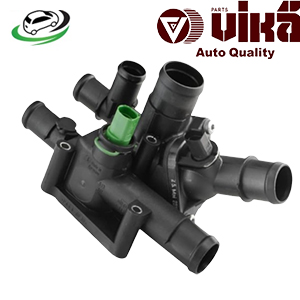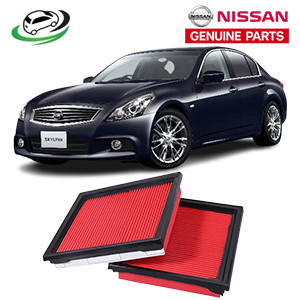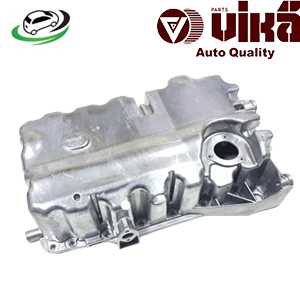-8%
Get VW Golf Mk5 2.0 FSI Oil Sump 06F103601F
The oil sump, also known as the oil pan, is an essential component of the engine’s lubrication system. It plays a critical role in storing, cooling, and supplying engine oil, ensuring that the moving parts of the engine are well-lubricated. This explanation will dive into the functions, benefits, common signs of wear, and maintenance tips for an oil sump, providing a comprehensive understanding of its importance in vehicle operation.
Function of the Oil Sump
The oil sump serves several crucial functions that contribute to the smooth operation of an engine:
- Oil Storage:
- The primary function of the oil sump is to act as a reservoir for engine oil. After circulating through the engine, oil drains back into the sump, where it is stored until it is pumped through the system again. Depending on the vehicle, the oil sump can hold several quarts of oil, which is critical for keeping the engine lubricated during operation.
- Oil Cooling:
- As the oil passes through the engine, it absorbs a significant amount of heat generated by the combustion process and friction between moving parts. The oil sump helps dissipate this heat, cooling the oil before it is recirculated through the engine. In some vehicles, the sump is designed with fins or other structures to improve heat dissipation, enhancing the oil cooling effect.
- Oil Drainage and Circulation:
- The oil sump collects oil that flows back from the engine after lubrication and sends it back to the oil pump. From there, the oil is pumped through the engine’s oil galleries to lubricate critical components, such as the crankshaft, camshaft, pistons, and valve train. This cyclical process ensures that the engine’s moving parts remain well-lubricated, minimizing friction and preventing wear.
- Foreign Particle Collection:
- During the engine’s operation, various particles such as dirt, metal shavings, or debris may enter the oil. The oil sump allows some of these contaminants to settle at the bottom, preventing them from circulating through the engine. The oil filter further aids in this process, but the sump still plays a role in trapping larger particles.
- Sealing the Bottom of the Engine:
- The oil sump acts as a sealing structure for the bottom of the engine, preventing oil from leaking out. It is usually bolted to the underside of the engine block and sealed with a gasket to prevent leaks. A leak-free seal is crucial for maintaining proper oil pressure and preventing oil loss.
- Facilitating Oil Changes:
- Most oil sumps are equipped with a drain plug that allows old oil to be drained easily during oil changes. This makes it convenient to remove used oil and replace it with fresh oil, ensuring the engine continues to receive optimal lubrication.
Types of Oil Sumps
There are two primary types of oil sumps used in vehicles:
- Wet Sump:
- The wet sump system is the most common type of oil sump used in vehicles. In this system, the oil sump is located at the bottom of the engine, and oil is stored directly in the sump. The oil pump draws oil from the sump and circulates it through the engine before it drains back into the sump.
- Wet sump systems are simpler, less expensive, and easier to maintain. They are ideal for everyday vehicles, such as cars, trucks, and SUVs.
- Dry Sump:
- In a dry sump system, oil is not stored in the sump but in a separate reservoir. A series of pumps draw oil from the sump, store it in the reservoir, and then pump it back into the engine as needed. Dry sump systems are typically used in high-performance vehicles, such as race cars or motorcycles, as they offer better oil control under extreme conditions, such as high speeds and sharp turns.
- Dry sump systems prevent oil starvation in performance settings where a wet sump system may not keep up with the demand for lubrication. However, they are more complex, expensive, and harder to maintain.
Benefits of the Oil Sump
The oil sump provides several key benefits that contribute to the overall performance and longevity of an engine:
- Optimal Lubrication:
- The oil sump ensures that the engine always has a supply of oil ready for circulation. It acts as a central storage unit for the engine’s lubricant, keeping the system constantly supplied with fresh oil. This lubrication prevents metal-on-metal contact within the engine, reducing friction and wear on moving parts.
- Cooling the Engine:
- The oil sump helps lower the temperature of the oil after it circulates through the engine. By dissipating heat, the sump plays an indirect role in helping maintain a stable engine temperature. This cooling effect prevents oil from overheating and losing its lubricating properties, ensuring that the engine remains properly lubricated.
- Preventing Engine Damage:
- By collecting and cooling the oil, the sump helps prevent engine components from seizing or wearing prematurely. Without a functioning oil sump, the engine would quickly lose lubrication, leading to increased friction, excessive heat, and potential damage to key components such as the crankshaft and bearings.
- Simple Oil Change Process:
- The oil sump simplifies oil changes by incorporating a drain plug. This allows old oil to be easily drained from the system, making regular maintenance more convenient for vehicle owners. Proper oil changes are critical to maintaining engine health.
- Supporting High-Performance Vehicles:
- In performance vehicles with dry sump systems, the oil sump plays an even more critical role in preventing oil starvation during aggressive driving. By ensuring constant oil circulation, even under extreme conditions, it allows high-performance vehicles to operate at peak efficiency without risking engine damage.
Signs of a Worn-Out Oil Sump
Over time, the oil sump may develop issues that can compromise its ability to function effectively. Here are some common signs of a worn-out or damaged oil sump:
- Oil Leaks:
- One of the most common signs of a worn-out oil sump is an oil leak. Leaks can occur if the sump is cracked, if the gasket is damaged, or if the drain plug is loose or improperly sealed. If you notice oil spots or puddles under your vehicle, it may indicate a problem with the oil sump.
- Dents or Damage:
- Since the oil sump is located on the underside of the engine, it is vulnerable to damage from road debris, curbs, or speed bumps. A dented or cracked oil sump can lead to oil leaks or a restricted oil flow, potentially causing engine lubrication issues.
- Low Oil Levels:
- If the oil sump is leaking or damaged, you may notice that your oil levels are consistently low. This is because the engine oil is escaping through cracks or leaks in the sump. Consistently low oil levels can lead to engine damage if not addressed.
- Engine Overheating:
- A damaged oil sump can result in poor oil circulation or cooling, which in turn causes the engine to overheat. If your engine temperature rises quickly or if the temperature gauge reads higher than usual, it could indicate that the oil sump is not functioning properly.
- Check Engine Light:
- Some modern vehicles are equipped with sensors that monitor oil pressure and oil levels. If the oil sump is leaking or damaged, it may trigger the “Check Engine” or oil warning light on your dashboard. This light can be an early indicator of oil sump issues.
- Unusual Engine Noises:
- Without sufficient oil supply, the engine’s moving parts may start to grind or make knocking noises due to increased friction. This noise could be a sign that the oil sump is not providing enough lubrication due to a leak or damage.
Maintenance Tips for the Oil Sump
Proper maintenance of the oil sump is essential for ensuring the longevity and performance of the engine. Here are some maintenance tips to keep your oil sump in good working condition:
- Regular Oil Changes:
- Changing the engine oil regularly helps keep the sump free from sludge and debris that can build up over time. Clean oil is less likely to clog or damage the sump, ensuring optimal lubrication and cooling for the engine.
- Inspect for Leaks:
- Regularly inspect the area around the oil sump for signs of leaks. Check for oil spots under the vehicle, and inspect the sump gasket and drain plug for signs of wear or damage. Early detection of leaks can prevent more significant engine issues down the line.
- Avoid Road Hazards:
- Since the oil sump is located on the underside of the vehicle, it is susceptible to damage from road debris or rough terrain. Avoid driving over curbs, speed bumps, or large obstacles that could dent or puncture the oil sump.
- Tighten Drain Plug Properly:
- During oil changes, ensure that the drain plug is tightened to the manufacturer’s specifications. Overtightening can strip the threads, while under-tightening can cause leaks. Always use a torque wrench to achieve the correct tightness.
- Replace Worn Gaskets:
- The gasket between the oil sump and the engine block can wear out over time, leading to leaks. If you notice oil seeping from around the sump, it may be time to replace the gasket. It’s a relatively simple repair that can prevent oil loss and maintain oil pressure.
- Inspect for Physical Damage:
- Periodically inspect the oil sump for dents, cracks, or other physical damage. If you notice any damage, have the sump repaired or replaced to prevent further issues.
- Use the Correct Oil Type:
- Always use the manufacturer-recommended oil type for your vehicle. Using the wrong type of oil can lead to poor lubrication, increased wear, and potential damage to the oil sump.
Conclusion
The oil sump is a critical component of the engine’s lubrication system, ensuring optimal oil storage, cooling, and circulation. By maintaining the oil sump through regular oil changes, inspections, and careful driving, vehicle owners can ensure their engine stays well-lubricated and protected. Understanding the functions, benefits, and maintenance of the oil sump is key to prolonging engine life and preventing costly repairs.
Follow us on Facebook for more parts.




Reviews
Clear filtersThere are no reviews yet.